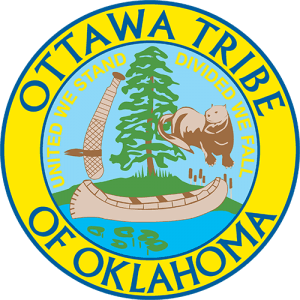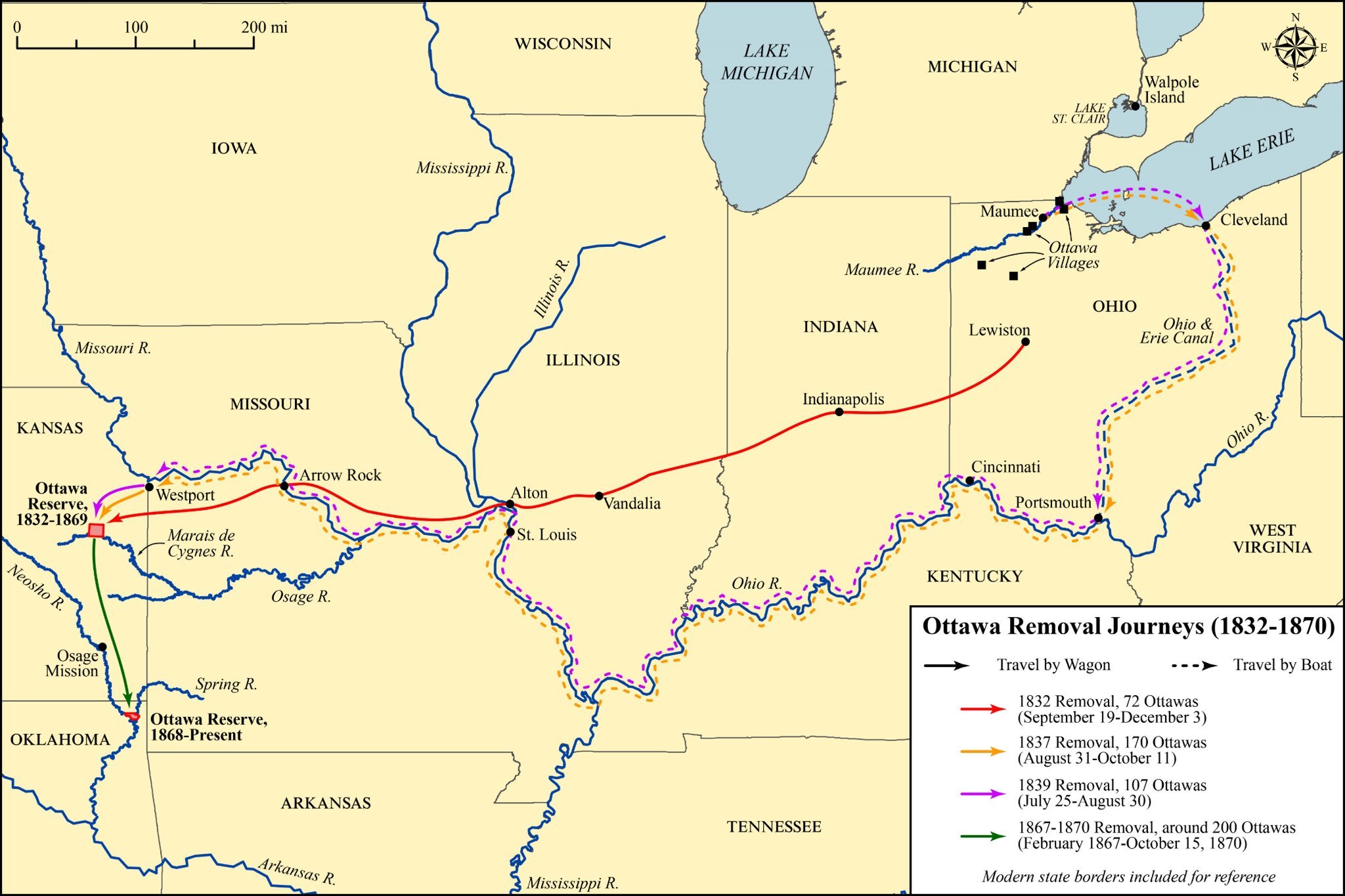
Our History.
THE GREAT LAKES
Our ancestors had several villages around and within the Western basin of Lake Erie, known in our language as “Gitche Gumegsuwach” (Get-she-gum-eg-sug wach). The Ottawa people have always made their villages and encampments on islands, on the edge of lakes or in the fork between rivers. These villages would be moved a short distance every three years to allow for the regrowth of fishing and hunting. After nine years the village would be back in its original place. The village of Ogantz was one of the largest villages and the center of the Ottawa trade route (now the present city of Marble Head, Michigan north of Sandusky Bay).
From this village the Ottawa would cross the Gitche Gumegsugwach (Lake Erie) and trade with Detroit using North Bass Island as a stopping/trading point during their travels. The Ottawa had formed small villages on each of the islands: Mens-neswe-kewadin (North Bass), Mens-neswe-notin (Middle Bass), and Mens-neswe-shahwun (South Bass) to protect their trade routes and to form trading posts where both the French and English could come and trade. The Island villagers hunted, farmed, gathered wild rice, nuts, and berries, and fished the channels between the islands using gill nets. From North Bass Island they could travel east to point Pelee, and northwest to Detroit, and Walpole Island. The Ottawa also had several other villages on the lake’s edge and on the rivers surrounding the western basin of the lake. These were located on the Sandusky River, Portage River, Blanchard River, Auglaize River, and Maumee River. Other villages were Waseonoquet, Otokee, Oquanoxa, and Tontogany,. The Maumee River is where Pontiac made his summer home on the island at Roche De Boeuf.
REMOVAL 1830-1839
By 1830, the time was ripe for the expulsion of the Ottawa from their homeland in Ohio. On May 28, 1830, the United States government sanctioned the unfavorable policy of the new settlers towards the Indians by passing the Removal Act. In 1831, the first group of Ottawa was removed to Kansas. These included the tribesmen living in towns on the Auglaize River and on the Maumee River above Toledo. The removal was a tragic one: the few Indians who had money were robbed by the whites en route, horses broke down or were stolen, and a good portion of the Indians became sick and many died. No provisions or doctors were awaiting them on their arrival in Kansas as the government had promised. In addition, no provision had been made to supply them with plows or materials needed to start the spring planting as was promised in the removal treaty. Some of the more heartsick of the Ottawa made the long and tiring trek back to the Ohio country, and the misery of the migration lost nothing of its luridness in the stories that these Indians told to the remaining tribes.
WAR WITH THE BRITISH
The Indians grew tired of the English pushing them off their lands and formed a rebellion with Ottawa Chief Pontiac as the leader. He led the Indians against the British forts in 1763. The confederation of Indians was successful against ten out of the thirteen forts in the territory. After the siege of the forts, hostilities ended in November 1765.
A map depicting the journeys of the Ottawa from their ancestral homelands to Kansas and ultimately to Indian Territory in Oklahoma. Map courtesy of Ottawa Tribal member Dr. David Dry, PhD.
By 1832, the Ottawa of northern Ohio were faced with the problem of survival. Lieutenant J.P. Simonton, a government official sent to help remove the Ottawa, reported that they were rapidly becoming pressed for subsistence, that game in the area was growing scarce; and, that the traders had ceased to supply the Ottawa with food and goods. With these sources of food cut off, the Ottawa had few options. They could agree to remove to the strange lands in the West, they could remain in their homeland and face starvation and brutal treatment by the whites; or, they could try to escape to their friends in Canada where they were always welcome.
In 1837, The New York Times had this to say about the Ottawa: “One hundred and sixty-six Indian men, women, and children of the Ottawa tribe passed through Louisville last Monday, from Maumee, Ohio on their way to Osage River, under the charge of Col. M’Ilvaine. Of all the forlorn and wretched-looking set of individuals, whom we have looked upon for some time past, we willingly concede to these the stamp of degradation appears much more visible in their bloated and disfigured countenance and evinces at once that the fierce and warlike souls of their sires, animates no more in the bosom of this degenerated race of men.”
In 1839 the last of the Ottawa were removed to Kansas lands. During these removals, however, the agents often turned their heads and allowed Ottawa families to escape to Canadian shores, and a great many were saved from the brutal removal in this way. The families would use the islands as a refuge and hiding place on the way to Canada. About half of the original number did make their escape to Canada, and settled with their brethren the Chippewa and Potawatomie on Manitoulin Island, at Sarnia Reserve, or on Walpole Island. As for the Ottawa who were forced from their homelands nearly half of them perished in their first year in Kansas.
KANSAS 1832-1867
In 1833 Reverend Jotham Meeker came to the Ottawa’s territory and with him came a better living for the Ottawa. He helped the Ottawa by teaching them and by making sure that they were not taken advantage of by the white man. The Ottawa knew that to survive their children must be educated. In 1862, the Ottawa were allotted 74,000 acres of land. They made a treaty with the Baptist church and gave 20,000 acres of land to be used and sold to raise money to build a Baptist school for the education of whites and Indians. The Indians made an arrangement in the treaty that the Ottawa children would be educated free of charge. The school started in 1865, and 2 Ottawa students were educated but once more in 1867, they were removed. The Ottawa sold their land in Kansas and were removed to Indian Territory, in Oklahoma. Later the school was named Ottawa University after the Ottawa. The reservation where the Ottawa lived became a township named after them.
OKLAHOMA
In 1867, the Ottawa tribe entered into a contract with the Shawnee tribe to purchase (approximately 14,800 acres) which was part of the Shawnee reservation. They thought that by owning the land they would never be moved, and would be left alone. When the tribe moved to Oklahoma in 1867 more of the Ottawa had died and only about 200 were left. But once more the government intervened and split up the Ottawa’s land. It was allotted out and the remainder sold to the white man. For a time, the Ottawa lived in peace. Then in 1956, the United States government decided that the Ottawa Tribe served no purpose and terminated them as a tribe. This was a long dark period in the Tribe’s history. The tribe remained committed and on May 15, 1978, the Ottawa Tribe was restored. Since then, the tribe has started to grow. We now have approximately 4000 members. Tribal businesses include two convenience stores, a casino, and a diner with more projects being planned. One of the biggest accomplishments for the tribe came in 2009 when the Ottawa Tribe and Ottawa University signed a new treaty stating that the University would provide free education to all Ottawa tribal members.
Rhonda Hayworth
Library/Archives, Higher Ed., Tribal Historic Preservation
Office: 918-542-5191
E-mail: rhonda.oto@gmail.com





